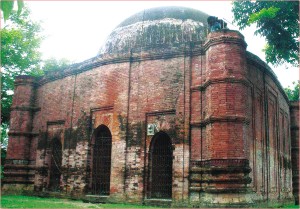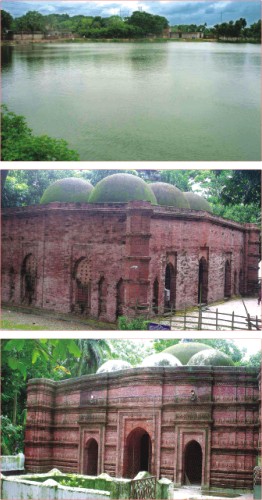| Journey through Bangladesh
From Jhenidah
Mosques from the Sultani Period
 In Barobazar, Jhenidah, once lived twelve Aulias. Barobazar is famous for its treasures such as its 10 mosques, 11 lakes and 4 graves of the Sultani period. There lived twelve Aulias in each 12 different bazaars. For which this historical capital was termed as Barobazar. In Barobazar, Jhenidah, once lived twelve Aulias. Barobazar is famous for its treasures such as its 10 mosques, 11 lakes and 4 graves of the Sultani period. There lived twelve Aulias in each 12 different bazaars. For which this historical capital was termed as Barobazar.
This habitation of twelve Aulias is located 11 kilometers to the south of Kaligonj upazila and 26 kilometers from the district town. The Dhaka-Khulna highway runs through it. These beautiful mosques of great archaeological value were established during the Sultani period. These ten mosques are some of the best archaeological sites in the country; they have lost most of their captivating artistic features due to the lack of proper maintenance and supervision.
Although time and nature have damaged most of the red terracotta plaques on the 500 year old mosques, their shape and structure still bear testimony to the rich legacy of the archaeological sites.
The roofs of the mosques are inwardly concave with a thickness of wall 3.6 feet. Its height is 25 feet. Cracks have started to develop on the wall. Shrubs and trees have been growing all over the structure and this has become a shelter for stray animals. The domes are also noteworthy.
Atiar Rahman, caretaker of the mosques, said a stone inscription was recovered while discovering the Satgachia mosque in 1987.
The name of Mahmood Ebn-A-Hossain Saha Sultan Al-Mozaffar was inscribed on the stone which was preserved at the Rajshahi University Museum, said Atiar Rahman. He added that the name of Barobazar was Mohammadi Bagh at that time.
These traditional mosques are Galakata Mosque, Jore Banglar Mosque, Gorar Mosque, Pir Pukur Mosque, Cherug Dani Mosque, Satgachia Mosque, Shukur Mollick Mosque, Noon Golla Mosque, Pathagar Mosque and Monohar Mosque.
The large lakes are Kharer Dighi, Shaudagar Dighi, Pir Pukur, Gorar Pukur, Golakata Pukur, Jore Banglar Dighi, Satgachia Dighi, Khondokar Dighi, and Ber Dighi. The four famous graves are Namajga grave, Ghoper Dhibi, Rani Matha, and the Badidehi grave.
 Barobazar was once an ancient capital city on the Bhairab River. It was the only Sea route to reach the eastern part from Gour and Patoliputra. The domes of the Bagerhat Shat Gambuj Mosque resemble to these 10 mosques here. These stones were transported by the river Bhairab and these mosques were constructed. According to historical records, 10 mosques were built during Sultani era, and 11 lakes were excavated during the same period. The Muslim period came to an end and the provincial capital Barobazar became desolate. At one stage, these structures were reduced to ruins without any maintenance and supervision. Barobazar was once an ancient capital city on the Bhairab River. It was the only Sea route to reach the eastern part from Gour and Patoliputra. The domes of the Bagerhat Shat Gambuj Mosque resemble to these 10 mosques here. These stones were transported by the river Bhairab and these mosques were constructed. According to historical records, 10 mosques were built during Sultani era, and 11 lakes were excavated during the same period. The Muslim period came to an end and the provincial capital Barobazar became desolate. At one stage, these structures were reduced to ruins without any maintenance and supervision.
In 1987, the Khulna Regional Archeological Department got rediscovered these sites. Abul Kalam Azad, Chairman of No-9 Barobazar Union said the roads that lead to the mosques were uneven and rugged. People face difficulties going to the mosques because of torn roads. Barriers should be built so that cattle cannot wander off and ruin these sites. Furthermore, rest-houses must be built for visitors.
Shihab Uddin Md. Akbar, Regional Director of the Archeological Department, Khulna agreed that these mosques were built during the Sultani period (1500) and rediscovered in 1987. He added that initiatives would be taken to repair and maintain these mosques. Satgachia mosque in 1987.
The name of Mahmood Ebn-A-Hossain Saha Sultan Al-Mozaffar was inscribed on the stone which was preserved at the Rajshahi University Museum, said Atiar Rahman. He added that the name of Barobazar was Mohammadi Bagh at that time.
These traditional mosques are Galakata Mosque, Jore Banglar Mosque, Gorar Mosque, Pir Pukur Mosque, Cherug Dani Mosque, Satgachia Mosque, Shukur Mollick Mosque, Noon Golla Mosque, Pathagar Mosque and Monohar Mosque.
The large lakes are Kharer Dighi, Shaudagar Dighi, Pir Pukur, Gorar Pukur, Golakata Pukur, Jore Banglar Dighi, Satgachia Dighi, Khondokar Dighi, and Ber Dighi. The four famous graves are Namajga grave, Ghoper Dhibi, Rani Matha, and the Badidehi grave.
Barobazar was once an ancient capital city on the Bhairab River. It was the only Sea route to reach the eastern part from Gour and Patoliputra. The domes of the Bagerhat Shat Gambuj Mosque resemble those of these 10 mosques here. These stones were transported by the river Bhairab and these mosques were constructed. According to historical records, 10 mosques were built during Sultani era, and 11 lakes were excavated during the same period. The Muslim period came to an end and the provincial capital Barobazar became desolate. At one stage, these structures were reduced to ruins without any maintenance and supervision.
In 1987, the Khulna Regional Archeological Department rediscovered these sites. Abul Kalam Azad, Chairman of No-9 Barobazar Union said the roads that lead to the mosques were uneven and rugged. People face difficulties going to the mosques because of torn roads. Barriers should be built so that cattle cannot wander off and ruin these sites. Furthermore, rest-houses must be built for visitors.
Shihab Uddin Md. Akbar, Regional Director of the Archeological Department, Khulna agreed that these mosques were built during the Sultani period (1500) and rediscovered in 1987. He added that initiatives would be taken to repair and maintain these mosques.
Copyright
(R) thedailystar.net 2008 |

